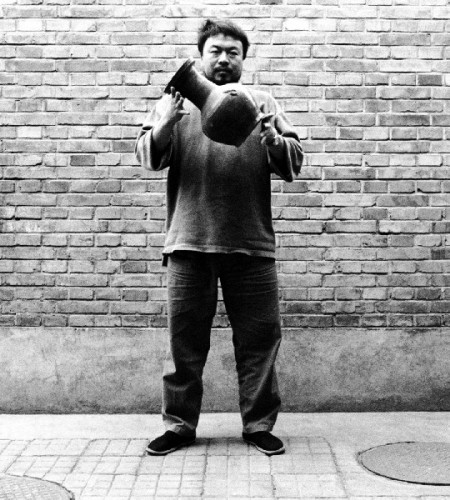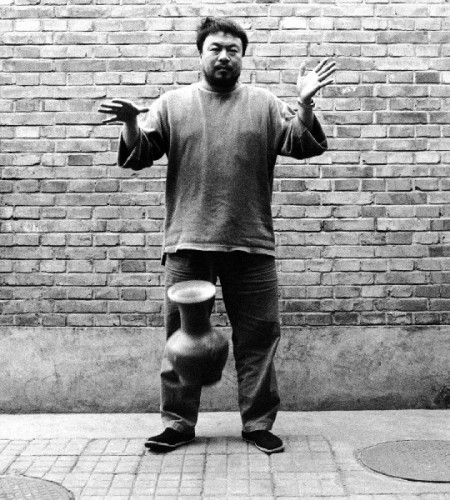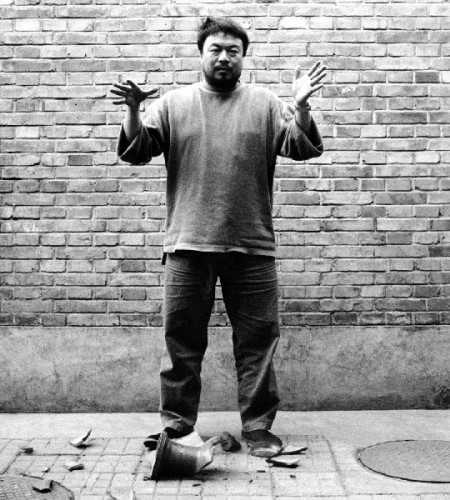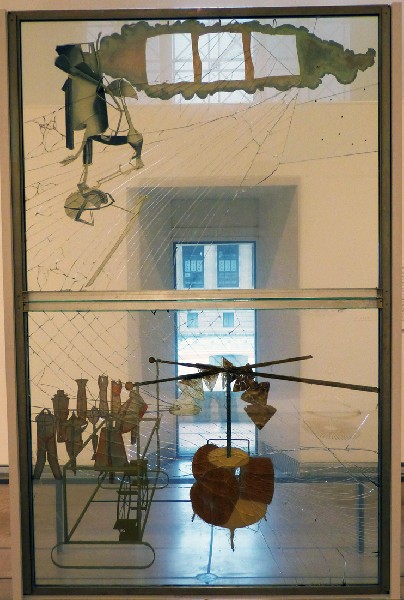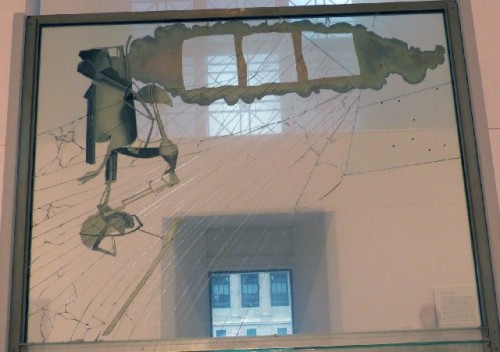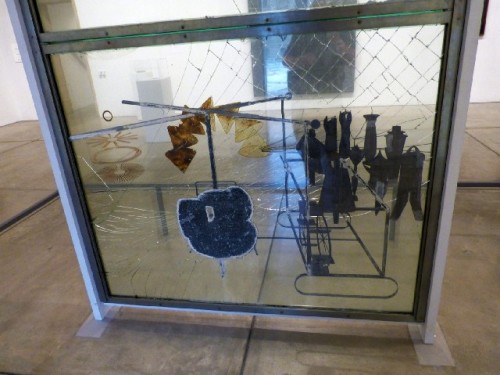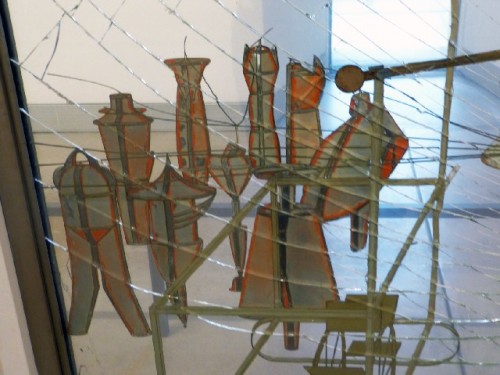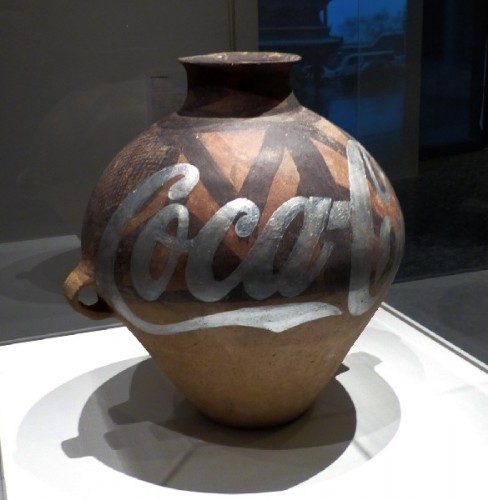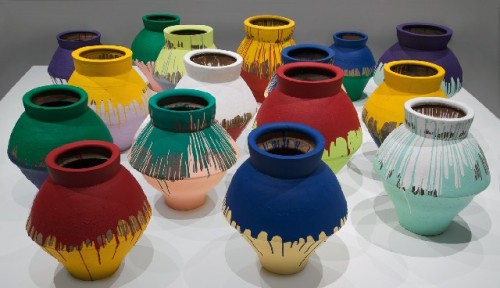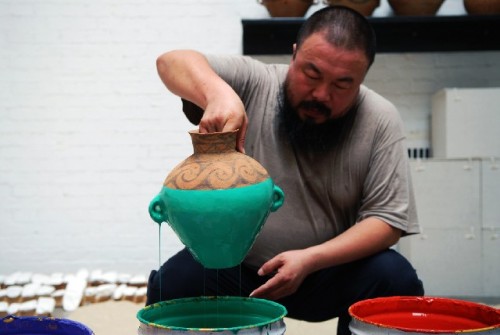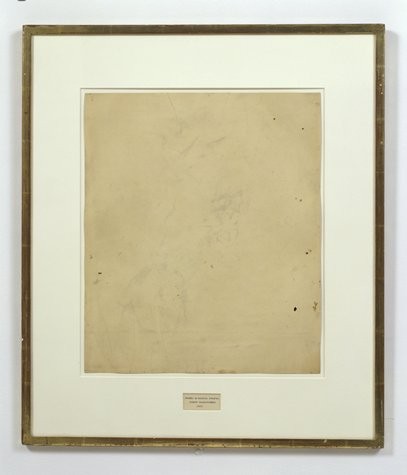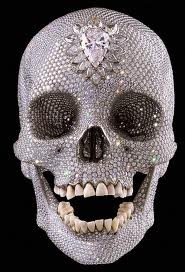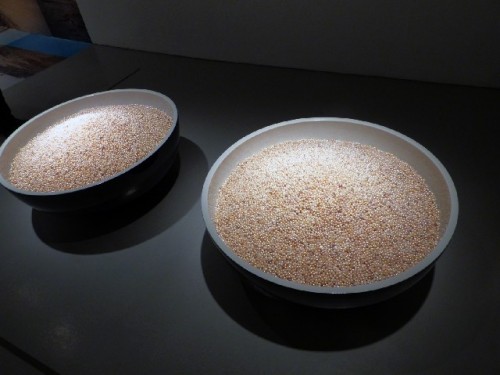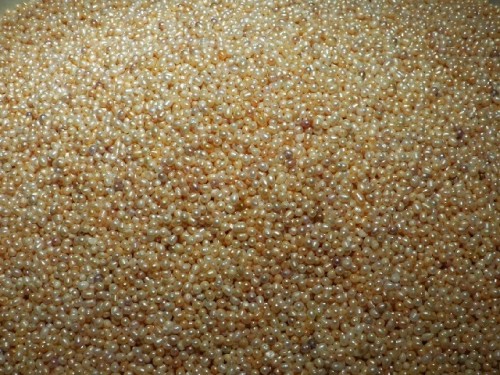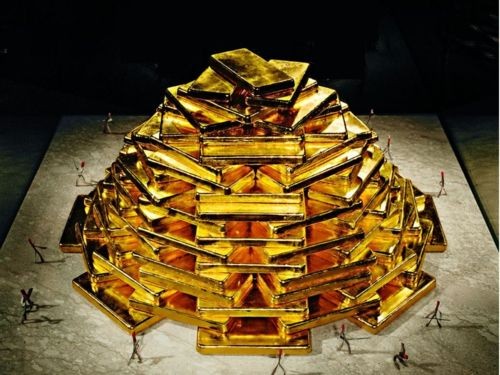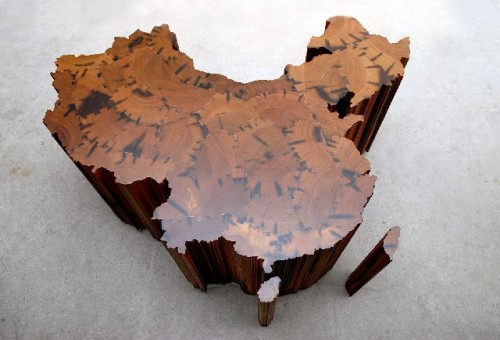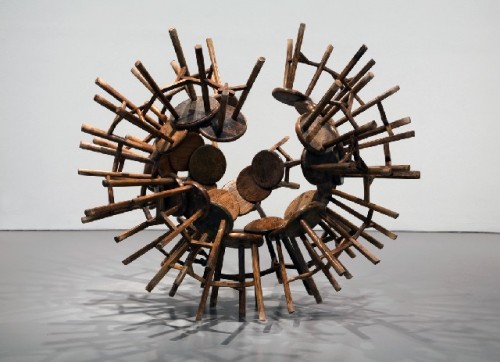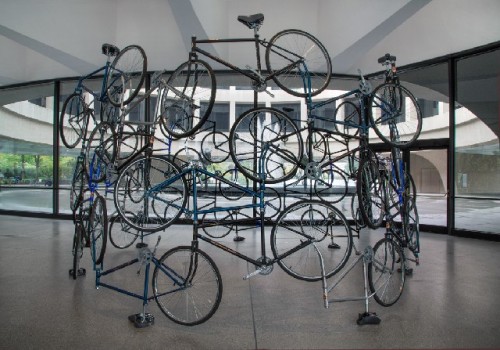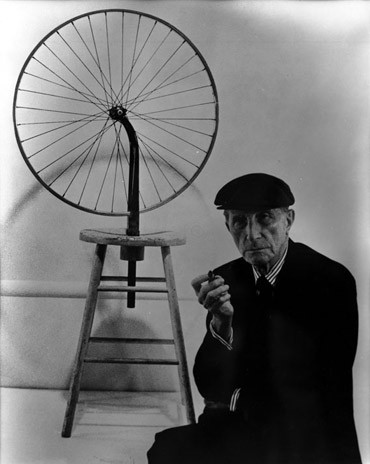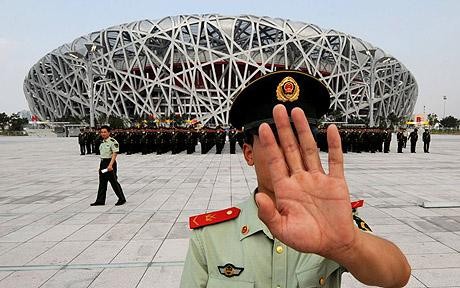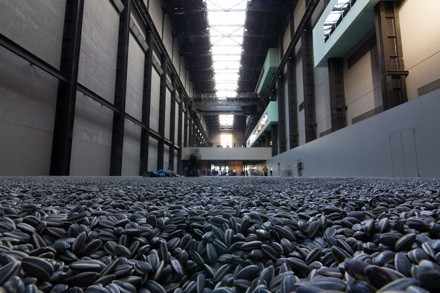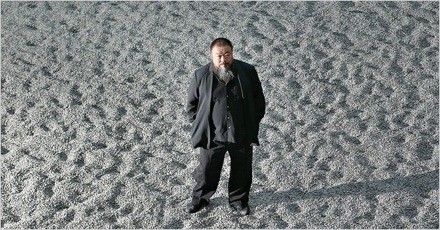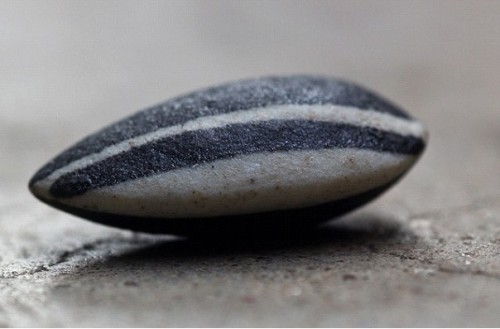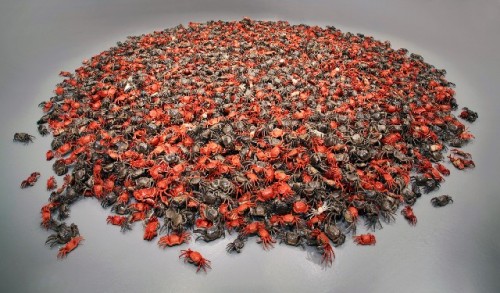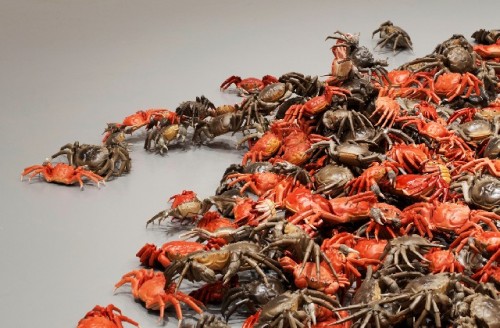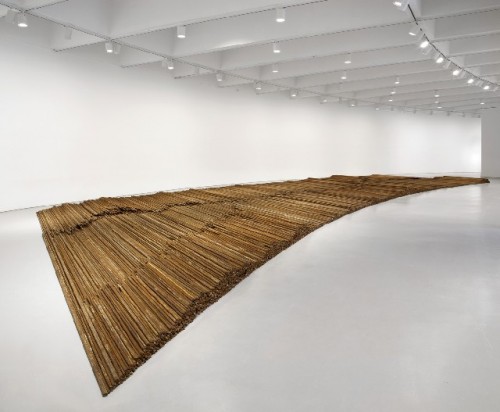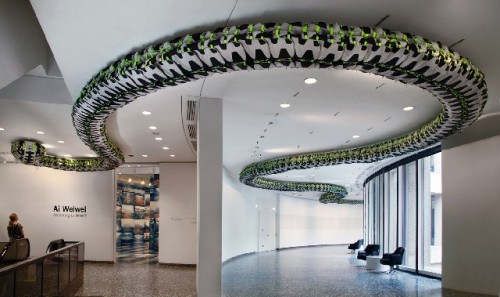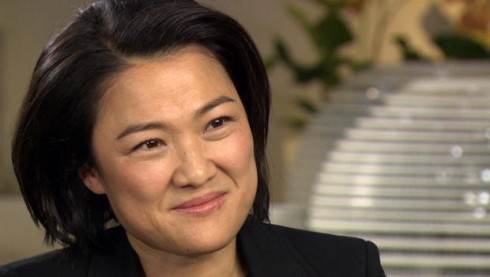Ai Weiwei: According to What?
Traveling Exhibition Tours Five Museums
By: Charles Giuliano - Mar 11, 2013
Ai Weiwei: According to What?
Organized by the Mori Art Museum, Tokyo and Smithsonian’s Hirshhorn Museum
Hirshhorn Museum and Sculpture Garden
Washington, D.C.
Oct. 7 through Feb. 24, 2013
Indianapolis Museum of Art
Indianapolis, Indiana
April 5 to July 28, 2013
Art Gallery of Ontario
Toronto, Canada
August 31 to October 27, 2013
Perez Art Museum Miami
Miami, Florida
November 28 to March 15, 2014
Brooklyn Museum
Brooklyn, New York
April 18 to August 10, 2014
In a 1995 set of three paradigmatic, black and white photographs, Ai Weiwei (Born Beijing, 1957), the conceptual Chinese artist, iconoclast, and dissident, is documented “Dropping a Han Dynasty Urn.”
The setting is austere and generic. The artist is shown dressed informally standing with weight distributed on spread legs in front of a brick wall. In the first image the precious, antique, ceramic urn is held with two hands at an angle just under his chin. In the second his hands are spread out with bent elbows as the dropping object has reached knee high. In the third with no change of impassive facial expression the urn is shattered below him.
These now iconic images represent the essence, power, controversy and conundrum of China’s most dangerous and threatening dissident, one of the world’s most celebrated and influential artists.
As a variant on the truism that “In order to make omelets you have to crack eggs” this action, a willful act of vandalism, is essential to an understanding of Ai Weiwei: According to What? the riveting exhibition which we visited in mid February at the Hirshhorn Museum and Sculpture Garden. It has since closed and will open on April 5, at the Indianapolis Museum, the next stop of a tour of five museums.
There are many ways to interpret the symbolism of smashing a priceless, 2000 year old urn, a sacrosanct artifact, and signifier of China’s ancient cultural heritage.
It is an act of violence and disruption which might be compared to the revolution which created Mao’s People’s Republic of China in 1949. Like that urn millions were smashed under Mao. Millions like Ai’s father a poet, were humiliated, banished to the provinces, and forced to do menial labor during the Cultural Revolution. Ai’s father, an artist and intellectual, was assigned to clean latrines.
Compared to which smashing an urn is a benign metaphor.
It conveys that an artist must be willing to let go and make a sharp break from the weight of heritage in order to create reenergized art.
Nothing about this is particularly new other than the context.
F. T. Marinetti’s 1909 Futurist Manifesto states that “We want to demolish museums and libraries, fight morality, feminism and all opportunist and utilitarian cowardice… To admire an old picture is to pour our sensibility into a funeral urn instead of casting it forward with violent spurts of creation and action.”
It is more than speculation to locate Ai’s art practice within the matrix of modernism, the avant-garde, Marcel Duchamp, the trajectory of the found object, ready made, assisted ready made, through the social sculptures of Joseph Beuys, the neo realism of Johns and Rauschenberg, the media tropes of Warhol or the conceptual performances of Chris Burden and Marina Abramovic.
Even before they left China for long residences in the West Ai, his friend Xu Bing, and others of their circle were circulating texts and information about the avant-garde. They later collaborated to publish Black Cover Book (1994), White Cover Book (1995) and Grey Cover Book (1997).
His decade in the U.S. is documented by “New York Photographs” (1983–93). While enrolled as a student at Parsons the young artist roamed the streets of Manhattan and became an integral part of the downtown art scene. He also enjoyed frequent gambling excursions to Atlantic City. In 1993 Ai’s father, Ai Qing, became ill and his son returned to a swiftly modernizing China.
Reviewing a 2007 exhibition of work by Huang Yong Ping at Mass MoCA we wrote “Entering a small constructed space we encounter a work from 1994 ‘The Wise Man Learns from the Spider How to Spin the Web,’ by the artist, Huang Yong Ping, who was born in rural Xiamen, China, in 1954. There is a small, simple writing table with several Xeroxed copies of texts in Chinese with images by Marcel Duchamp. Suspended above is a cone like structure with thin ribs covered by metal screening. Inside is a low wattage bulb and, at the bottom of the fixture, a transparent plastic bottom on which a tarantula is observed. A trap door is carefully concealed through which the spider is removed or fed. The lighting casts an elaborately patterned shadow on the surrounding walls creating a soft and meditative mood.”
As a part of that retrospective Ping “laundered” avant-garde texts in a washing machine reducing them to pulp. It was an allegory of how these artists literally masticated avant-garde theory and regurgitated it as their work.
The shattered urn of Ai channels Duchamp’s “The Bride Stripped Bare by Her Bachelors, Even” which we revisited recently at the Philadelphia Museum of Art. The work in lead and dust sandwiched between sheets of glass was dropped and shattered. The artist reassembled the shards creating in the process a more spectacular object and icon of modernism.
We don’t know what happened to the shards of Ai’s smashed urn. Were they simply tossed in the dust bin of history? They don’t appear to survive as the relics of a performance in the manner of Burden.
Perhaps it is closer to the 1953 action when Robert Rauschenberg asked Willem deKooning for a drawing which he meticulously erased. Was the drawing destroyed and defaced? Did it cease an identify as a work by deKooning and become a work by Rauschenberg? There is the question of value. Was its worth in the art market diminished or enhanced?
In 1978 Richard Nixon “opened up” China just as Commodore Matthew C. Perry had by visiting the isolationist Japan in 1852.
Following Nixon’s diplomatic initiative the first American product to be imported by China was Coca Cola.
In 1994 Ai painted a Coca Cola logo onto a Han period ceramic vessel. Subsequently, he created a series of antique ceramics dipped, like glazing a pot, into bright colored paint.
Again there are many layers to this action. It plays upon issues of value and provenance in the thriving market for Chinese antiquities. Forgers have become skilled and sophisticated. So we have to wonder whether Ai has “recycled” real, expensive antiquities or forgeries. It underscores the thriving industry in China of mass producing cheap knock offs of Western goods. So there is a tweaking of intellectual property in Ai’s subversive works.
As a very rich artist Ai is able to play with notions of value. At the Hirshhorn we encountered two, meter wide cisterns “Bowls of Pearls” (2006). Like cash registers our minds calculate the net worth of what we are looking at.
Such displays of conspicuous wealth are not unique in contemporary art. Burden displayed a small pyramid of solid gold bars. He has also used coins in his installations. As a conceptualist operating on a shoestring budget Burden returned the “materials” to the bank after an exhibition.
In June, 2007 the British artist Damien Hirst exhibited “For the Love of God” a human skull recreated in platinum then encrusted with 8,601 diamonds weighing a total of 1,106.18 carats. Approximately £15,000,000 worth of diamonds was used. The asking price for the object was £50,000,000 ($100 million or 75 million euros). It was sold to a consortium that included Hirst and his gallery White Cube.
Ok. I know. Hirst is crass and should not be compared to Ai who has social and political strata to the work.
In “Map of China” (2008) “Table with Two Legs on the Wall” (2008),“Grapes” (2010) and other works the artist disassembles and rejoins stools, chairs and furniture from the Qing Dynasty (1644-1911). These works and the ring of stacked and joined bicycles of “Forever” (2003) trace their genealogy to Duchamp’s 1913 “Bicycle Wheel and Stool.”
What is unique about the most successful Chinese artists is their ability to create enormous, complex works employing factories and legions of assistants. For Ai this also entails numerous architectural projects. It started with the design and construction of his studio in Beijing. He is best known for collaboration with Herzog & de Meuron on the design for the main stadium—the “Bird’s Nest”—for the 2008 Olympic Games in Beijing.
For a 2010 installation in the vast Turbine Hall of Tate Modern in London the artist commissioned 100 million hand made, porcelain, sunflower seeds. Initially, visitors were allowed to walk over the vast work. Eventually, the dust from crushed porcelain became a health hazard. So that was halted but not before many pockets full of seeds were scooped up by fans. Check E Bay for their availability.
On the occasion of the government ordered destruction of his then recently built Shanghai studio, Ai was under house arrest for “tax evasion,” he hosted a feast of 10,000 river crabs which he was unable to attend. This led to “He Xie” (2010) a recreation of that event expressed as 3,000 precise, porcelain crabs. The title literally means “river crab” but is also used as a homophone for the word “harmonious.” The slogan of the Chinese Communist Party is “The realization of a harmonious society.” On the internet it refers to censorship.
Ai’s widely read blog was shut down by the government. With his passport revoked the artist remains under house arrest.
Like Warhol a part of his art entails access to the media. Fluent in English from a ten year residence in the US Ai is always willing to grant an interview. They reveal an engaging, inventive, humorous, Dada prankster and trickster. Although he has been assaulted and arrested by Chinese police he conveys a casual disregard for his own safety. This was poignantly captured in a video as a conversation with his mother.
This very real threat to his life was exacerbated by the relentless search for truth in the coverup that followed the May 12, 2008 earthquake in Sichuan. As the result of cost cutting “tofu construction” a school was demolished resulting in the death of 5,000 students and teachers. The government repressed the release of the names of the victims.
Since 2009 Ai has become increasingly known for outspoken political activism, which resulted in home invasion and a beating as well as detention in 2011 for 81 days by Chinese authorities. “I’ve experienced dramatic changes in my living and working conditions over the past few years,” Ai has stated, “and this exhibition has been an opportunity to reexamine past work and communicate with audiences from afar. I see it as a stream of activities rather than a fixed entity. It is part of a continual process in self-expression.”
Using the internet and twitter Ai organized a massive effort to identify the lost children. A wall in the exhibition displays their names and vital statistics. The artist has organized readings of the 5,000 names.
When he visited the site Ai was struck by the imagery of many back packs of the fallen children. He has used back packs as the material for a number of sculptures commemorating the students. At the Hirshhorn we observed a giant snake coiling its way above us.
In the wreckage of the earthquake were twisted iron rods used in reinforced concrete construction. Sold as scrap metal the artist purchased tons of the material. A team of assistants using torches and hammers laboriously straightened out the bars. A stack (40 tons) is displayed as “Wenchuan Steel Rebar” (2008-2012).
The piece was inspired by the 2011 reconstruction of a 72,000 square meter school on the site of the destroyed building. It is an official way of saying that the disaster never happened. That, like Ai’s simple but dramatic piece, the government can straighten out the twisted, broken lives of 5,000 children.
Of the earth’s current population of 6.7 billion some 1.3 billion people reside in China. There has been enormous growth and change since the end of the reactionary Cultural Revolution. During a week in Shanghai, several years ago, was saw this dramatic progress with our own eyes. While still a communist country today there are entrepreneurs and billionaires in China. Recently 60 Minutes profiled China’s real estate mogul, Zhang Xin. She is the fifth richest self-made billionaire woman in the world. A second part of the broadcast focused on the disaster of an about to burst real estate bubble which will have global impact.
Like that crashing Han Dynasty vase it begs the question of what China we are dealing with. Is it the totalitarian, communist monolith of Mao? Or, like Ai, Xu Bing and other artists, is China today a confluence of Eastern heritage infused with Western ideas and the corruption of capitalism?
The work of Ai Weiwei is compelling precisely because of the fusion of ancient heritage and post modernism. It speaks to us with a readily understandable vocabulary of imagery. In this galvanic exhibition nothing is lost in translation. It is also a conundrum and false positive of very dangerous ideas. The oeuvre is a challenge to look deeper and wonder whether what see is what we get?
While we embrace China as the world’s fastest growing economy and culture never loose sight of the fact that it is a police state. Beware of complacency and stepping on the tail of the seemingly benign dragon.
Never Say Sorry video review.
Mary Boone exhibition.
Joe Thompson on Mass MoCA China projects.
Huang Yong Ping at Mass MoCA.
Cai Guo Qiang

